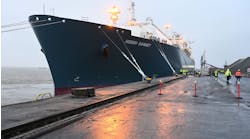Offshore staff
HELSINKI, Finland – Solstad Offshore has entered a collaboration with Wärtsilä to reduce CO2 emissions from its 90-strong offshore vessel fleet by 2030.
The aims are to identify, assess, and implement solutions for increasing fuel efficiency and cutting emissions. Each vessel will undergo reviews for suitable solutions, potential operational improvements, and life extension measures.
Solstad is targeting full carbon neutrality by 2050. Since 2009, the company has systematically introduced operational measures (Solstad Green Operations) and technical upgrades that to date have cut average fuel consumption per vessel by more than 20%.
Extending cuts to 50% should come from optimizing energy efficiencies and retrofits to enable the vessels to operate with alternative fuels such as hydrogen, ammonia, and methanol.
New vessels will be designed to provide low or zero emissions from the start of operations.
Around 30 years ago, Wärtsilä developed use of LNG as a viable marine fuel and more recently has tested ammonia as a fuel for both marine engines and fuel cells.
It successfully operated a combustion engine on a fuel mix with 70% ammonia content and is currently working on ways of raising this proportion.
The company also participates in the EU’s ShipFC project, the world’s first emissions-free offshore vessel operating with an ammonia-powered fuel cell.
“It is too early to determine which solutions will prove to be the most appropriate for meeting the GHG emission reductions envisioned by Solstad. However, it is extremely likely that future propulsion solutions operating with new alternative fuels, such as ammonia and/or methanol, will be key enablers as these fuels become widely available for bunkering,” said Roy H. Stavland, senior sales manager at Wärtsilä.
Initially, the company will serve as advisor and technical expert to Solstad, potentially later supplying the selected decarbonization solutions.
2/22/2022



